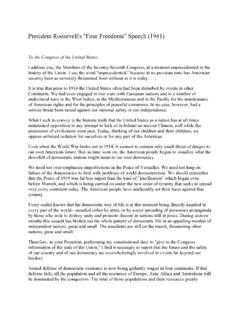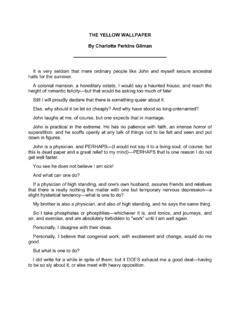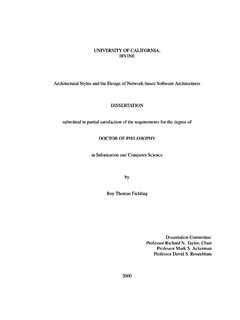Transcription of In-Text Documentation 161
1 APA Style American Psychological Association (APA) style calls for (1) brief doc . umentation in parentheses near each In-Text citation and (2) com . plete Documentation in a list of references at the end of your text. The models in this chapter draw on the Publication Manual of the American Psychological Association, 6th edition (2010). Additional information is available at A DIRECTORY TO APA STYLE. In-Text Documentation 161. 1. Author named in a signal phrase 161. 2. Author named in parentheses 162. 3. Authors with the same last name 162. 4. Two authors 162. 5. Three or more authors 163. 6. Organization or government as author 163. 7. Author unknown 163. 8. Two or more works cited together 164. 9. Two or more works by one author in the same year 164. 10. Source quoted in another source 164. 11. Work without page numbers 164. 12. An entire work 165. 13. Personal communication 165. Notes 165. 158. 158 11/22/13 8:39 AM. A Directory to APA Style APA 159. Reference List 166.
2 PRINT BOOKS 166. Documentation Map: Print Book 168. 1. One author 167. 2. Two or more works by the same author 167. 3. Two or more authors 167. 4. Organization or government as author 169. 5. Author and editor 169. 6. Edited collection 169. 7. Work in an edited collection 169. 8. Unknown author 170. 9. Edition other than the first 170. 10. Translation 170. 11. Multivolume work 170. 12. Article in a reference book 171. PRINT PERIODICALS 171. Documentation Map: Article in a Print Magazine 173. 13. Article in a journal paginated by volume 172. 14. Article in a journal paginated by issue 172. 15. Article in a magazine 172. 16. Article in a newspaper 174. 17. Article by an unknown author 174. 18. Book review 174. 19. Letter to the editor 174. ONLINE SOURCES 175. Documentation Map: Work from a Website 177. Documentation Map: Article in a Journal with DOI 178. Documentation Map: Article Accessed through a Database with DOI 180. 159 11/22/13 8:39 AM. 160 APA APA STYLE. 20. Work from a nonperiodical website 175.
3 21. Article in an online periodical 176. 22. Article available only through a database 179. 23. Article or chapter in a web document or online reference work 179. 24. Electronic book 179. 25. Wiki entry 181. 26. Online discussion source 181. 27. Blog entry 181. 28. Online video 182. 29. Podcast 182. OTHER KINDS OF SOURCES 182. 30. Film, video, or DVD 182. 31. Music recording 182. 32. Proceedings of a conference 182. 33. Television program 183. 34. Software or computer program 183. 35. Government document 183. 36. dissertation 184. 37. Technical or research report 184. SOURCES NOT COVERED BY APA 184. Formatting a Paper 185. Sample Pages 187. Throughout this chapter, you'll find models and examples that are color-coded to help you see how writers include source information in their texts and reference lists: brown for author or editor, yellow for title, gray for publication information: place of publication, pub . lisher, date of publication, page number(s), and so on.
4 Author title publication 160 11/22/13 8:39 AM. In-Text Documentation APA-a 161. APA-a In-Text Documentation Brief Documentation in your text makes clear to your reader pre . cisely what you took from a source and, in the case of a quotation, precisely where (usually, on which page) in the source you found the - text you are quoting. paraphrases and summaries are more common than quotations in APA-style projects. See R-4 for more on all three kinds of citation. As you cite each source, you will need to decide whether to name the author in a signal phrase as McCullough (2001) wrote or in parentheses (McCullough, 2001). Note that APA requires you to use the past tense or present perfect tense for verbs in signal phrases : Moss (2003) argued, Moss (2003) has argued.. 1. AUTHOR NAMED IN A SIGNAL PHRASE. If you are quoting, you must give the page number(s).You are not required to give the page number(s) with a paraphrase or a summary, but APA. encourages you to do so, especially if you are citing a long or complex work; most of the models in this chapter do include page numbers.
5 AUTHOR QUOTED. Put the date in parentheses right after the author's name; put the page in parentheses as close to the quotation as possible. McCullough (2001) described John Adams as having the hands of a man accustomed to pruning his own trees, cutting his own hay, and splitting his own firewood (p. 18). Notice that in this example, the parenthetical reference with the page number comes after the closing quotation marks but before the period at the end of the sentence. AUTHOR PARAPHRASED OR SUMMARIZED. Put the date in parentheses right after the author's name; follow the date with the page. John Adams's hands were those of a laborer, according to McCullough (2001, p. 18). 161 11/22/13 8:39 AM. 162 APA-a APA STYLE. 2. AUTHOR NAMED IN PARENTHESES. If you do not mention an author in a signal phrase, put his or her name, a comma, and the year of publication in parentheses as close as possible to the quotation, paraphrase, or summary. AUTHOR QUOTED. Give the author, date, and page in one parenthesis, or split the information between two parentheses.
6 One biographer (McCullough, 2001) has said John Adams had the hands of a man accustomed to pruning his own trees, cutting his own hay, and splitting his own firewood (p. 18). AUTHOR PARAPHRASED OR SUMMARIZED. Give the author, date, and page in one parenthesis toward the begin . ning or the end of the paraphrase or summary. John Adams's hands were those of a laborer (McCullough, 2001, p. 18). 3. AUTHORS WITH THE SAME LAST NAME. If your reference list includes more than one person with the same last name, include initials in all Documentation to distinguish the authors from one another. Eclecticism is common in contemporary criticism (J. M. Smith, 1992, p. vii). 4. TWO AUTHORS. Always mention both authors. Use and in a signal phrase, but use an ampersand (&) in parentheses. Carlson and Ventura (1990) wanted to introduce Julio Cort zar, Marjorie Agos n, and other Latin American writers to an audience of English-speaking adolescents (p. v). According to the Peter Principle, In a hierarchy, every employee tends to rise to his level of incompetence (Peter & Hull, 1969, p.)
7 26). author title publication 162 11/22/13 8:39 AM. In-Text Documentation APA-a 163. 5. THREE OR MORE AUTHORS. In the first reference to a work by three to five persons, name all contributors. In subsequent references, name the first author fol . lowed by et al., Latin for and others. Whenever you refer to a work by six or more contributors, name only the first author, followed by et al. Use and in a signal phrase, but use an ampersand (&) in parentheses. Faigley, George, Palchik, and Selfe (2004) have argued that where there used to be a concept called literacy, today's multitude of new kinds of texts has given us literacies (p. xii). Peilen et al. (1990) supported their claims about corporate corruption with startling anecdotal evidence (p. 75). 6. ORGANIZATION OR GOVERNMENT AS AUTHOR. If an organization name is recognizable by its abbreviation, give the full name and the abbreviation the first time you cite the source. In subsequent references, use only the abbreviation.
8 If the organization does not have a familiar abbreviation, always use its full name. FIRST REFERENCE. (American Psychological Association [APA], 2008). SUBSEQUENT REFERENCES. (APA, 2008). 7. AUTHOR UNKNOWN. Use the complete title if it is short; if it is long, use the first few words of the title under which the work appears in the reference list. Webster's New Biographical Dictionary (1988) identifies William James as American psychologist and philosopher (p. 520). A powerful editorial asserted that healthy liver donor Mike Hurewitz died because of frightening faulty postoperative care ( Every Patient's Nightmare, 2007). 163 11/22/13 8:39 AM. 164 APA-a APA STYLE. 8. TWO OR MORE WORKS CITED TOGETHER. If you cite multiple works in the same parenthesis, place them in the order that they appear in your reference list, separated by semicolons. Many researchers have argued that what counts as literacy is not necessarily learned at school (Heath, 1983; Moss, 2003). 9. TWO OR MORE WORKS BY ONE AUTHOR IN THE SAME YEAR.
9 If your list of references includes more than one work by the same author published in the same year, order them alphabetically by title, adding lowercase letters ( a, b, and so on) to the year. Kaplan (2000a) described orderly shantytowns in Turkey that did not resemble the other slums he visited. 10. SOURCE QUOTED IN ANOTHER SOURCE. When you cite a source that was quoted in another source, let the reader know that you used a secondary source by adding the words as cited in. During the meeting with the psychologist, the patient stated repeatedly that he didn't want to be too paranoid (as cited in Oberfield & Yasik, 2004, p. 294). 11. WORK WITHOUT PAGE NUMBERS. Instead of page numbers, some electronic works have paragraph num . bers, which you should include (preceded by the abbreviation para.) if you are referring to a specific part of such a source. In sources with neither page nor paragraph numbers, refer readers to a particular part of the source if possible, perhaps indicating a heading and the paragraph under the heading.
10 Russell's dismissals from Trinity College at Cambridge and from City College in New York City have been seen as examples of the controversy that marked his life (Irvine, 2006, para. 2). author title publication 164 11/22/13 8:39 AM. notes APA-b 165. 12. AN ENTIRE WORK. You do not need to give a page number if you are directing readers'. attention to an entire work. Kaplan (2000) considered Turkey and Central Asia explosive. When you are citing an entire website, give the URL in the text. You do not need to include the website in your reference list. To cite part of a website, see no. 20 on pp. 175 76. Beyond providing diagnostic information, the website for the Alzheimer's Association includes a variety of resources for family and community support of patients suffering from Alzheimer's disease ( ). 13. PERSONAL COMMUNICATION. Document email, telephone conversations, interviews, personal let . ters, messages from nonarchived electronic discussion sources, and other personal texts as personal communication, along with the person's initial(s), last name, and the date.











